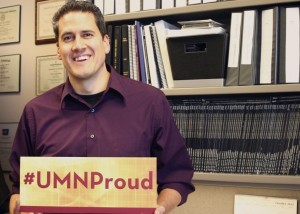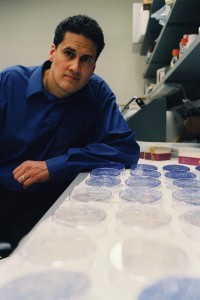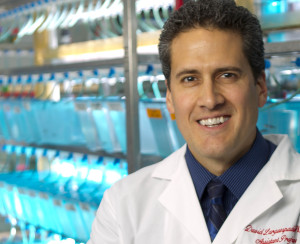Creativity in the War on Cancer: David Largaespada, Ph.D., University of Minnesota
By Stephen Dupont, APR, vice president, Pocket Hercules
I’ve known David Largaespada since my junior year at Prior Lake High School. We traveled in the same social circles then, playing soccer, Dungeon & Dragons, and just hanging out. Today, more than 30 years later, we see each other regularly, as we cycle together for Team Sprockets.
It’s a funny thing. You hang out with someone for many years and then you decide to interview him or her and are completely blown away by the work that that person is doing. That’s the case with Dave. I knew he did cancer research, but I never knew what fed his passion, what inspired him, or that he’s involved in several start-up companies leveraging cutting edge research that he and others at the University of Minnesota are developing. The lesson learned: Take some time to really talk to those friends you thought you knew so well – you might be surprised (shocked?) about what you might learn and gain a new appreciation for the valuable work that they do.
Stephen: I know you’re a cancer researcher, but can you explain exactly what you do?
Dave: In a nutshell, my laboratory is working to exploit insertional mutagenesis for cancer gene discovery and functional genomics in the mouse. We have invested heavily in the use of a vertebrate-active transposon system, called Sleeping Beauty (SB). SB is being used as a tool for forward genetic screens for cancer genes involved in osteosarcoma, hepatocellular carcinoma, gastro-intestinal tract and nervous system cancers. Other projects include development of mouse models of Neurofibromatosis Type 1 (NF1) associated cancer and testing new therapies in these models.

Stephen: And you run a large research lab at the University of Minnesota?
Dave: Yes. We currently have five post-doctoral candidates working in our lab doing cancer research, seven graduate level students, seven technicians, and 15 undergraduates. It’s located at the University of Minnesota near the TCF Stadium (the Bank), where I’m a member of our Masonic Cancer Center.
Stephen: In addition to running your research lab, you also teach, too.
Dave: Yes, I teach at the University of Minnesota, in addition, I do service work, fundraise, write grants, and of course, I work directly with graduate and undergraduate students on their research.
Stephen: One of your biggest breakthroughs is Sleeping Beauty, a gene therapy and gene discovery system. So, as I understand it, what you’re trying to achieve is a therapy that can be customized to treat a person’s cancer. Is that right?
Dave: In layman’s terms, our lab is studying the identity of the mutations and other changes that drive the development of cancer. By determining how those changes occur, we can develop genetic screening that allows us to treat cancer at the molecular level. We’re developing large-scale approach, based on the Sleeping Beauty transposon system, which allows us to identify cancer genes. We are primarily focused on several types of cancers (colorectal cancer, liver cancer, brain tumors, sarcomas, breast cancer tumors and a few others). SB also can be used to deliver therapeutic genes to human cells, including white blood cells, which can be used to turn them into efficient cancer killers.
Stephen: So, with your system, would it allow a doctor to more easily find cancer cells in a person’s body? In other words, a doctor would be able to tell if cancer is limited to just one area, such as the liver, or has spread to other parts of the body?
Dave: Well, our work using SB is mostly more basic than that. We’re learning about the genes and pathways that cause cancer and cause cancer cells to behave in the way the do. For example, our technology can help reveal the mechanisms that drive cancer cells to spread from the primary tumor to distant sites in the body.
Stephen: Why do you call it “Sleeping Beauty?”
Dave: Actually, SB was first created in the lab of one of my colleagues at the University of Minnesota, Dr. Perry Hackett. He named it Sleeping Beauty. We just figured out how to use it to study cancer. He called it Sleeping Beauty because his lab actually made an active transposon (or “jumping gene”) from inactive copies they had identified. Because they “resurrected” the transposon from millions of years of evolutionary sleep, they called it Sleeping Beauty.
Stephen: While you’re primarily focused on fighting cancer in humans, your system also could be used to detect and treat cancer in other types of animals, too, such as livestock, dogs, etc., too?
Dave: Certainly, our work reveals common mechanisms of cancer development that are operating in many species.
Stephen: Are you also developing treatments to eliminate cancer cells as part of your research program? Would your work one day replace chemotherapy or radiation therapy?
Dave: We are working with pharmaceutical companies to test new drugs and drug combinations. Also, we’re working on novel ways to trick the immune system into killing tumor cells specifically.
Stephen: And from your research, you’ve become involved with several start-up ventures?
Dave: Yes. I’ve co-founded three biotechnology companies, Discovery Genomics, NeoClone and B-MoGen, and I’m the chief science officer of a fourth company called Surrogen, which is a subsidiary of Recombinetics.
Stephen: What’s it meant to you to see your work move from the lab into a potentially commercial product that could save thousands of lives?
Dave: It’s an incredible privilege to have the chance to do this kind of work.
Stephen: So much research has been done to understand and fight cancer. How would you describe the landscape of cancer research today?
Dave: Ultimately, I feel that one day, cancer will become more like a chronic disease that we can manage through various therapies. It will not be the death sentence that many of us perceive it to be.
To me, I view the landscape like a giant war. It involves a lot of research, planning and execution. It’s understanding the enemy better and learning how to deliver more effective, efficient attacks.
There is still so much room for innovation in this field. There’s so much room for trying new approaches. And the thing is, we need that. We may need to develop and test thousands of different research approaches until we find the one treatment that eradicates cancer.

Stephen: How important is funding to ongoing cancer research?
Dave: It drives everything we do. It is hard and complex and expensive. That’s the reality of doing experiments that have never been done before and trying to achieve what seemed impossible less than a generation ago. The funding comes primarily from the federal government. Unfortunately, that money has been diminishing and lots of research that has merit goes unfunded at present. So, we and others, have tried to diversify our funding portfolio, getting funds form foundations, like the American Cancer Society, and from philanthropists interested in helping.
Stephen: How important is collaboration with others in your research?
Dave: It’s critical. And actually, it’s more enjoyable, too. I especially enjoy working on multidisciplinary teams. For example, combining my talents with a veterinarian to attack the problem of cancer in livestock.
Stephen: You’ve authored or co-authored more than 120 peer-reviewed research papers. Can you explain the value of research papers, and can you point to the one or two papers that someone should absolutely read if they’d like to know more about your research?
Dave: Our research papers provide a critical way for us to explain our new findings to the world, including educators, other scientists, journalists and even policy makers. This way our work can also be checked against others in the field to make sure its right – without this mechanism science couldn’t be self correcting, it couldn’t move the field forward quickly, and would be isolationist. With modern computer-based methods for searching and analyzing the research literature, one can quickly find out what is new in any field and where the field is headed and even make uncover new and unexpected links. Try reading these papers:
- Moriarity BS, Largaespada D.A. Sleeping Beauty transposon insertional mutagenesis based mouse models for cancer gene discovery. Curr Opin Genet Dev. 2015 Feb;30:66-72. doi: 10.1016/j.gde.2015.04.007. Epub 2015 Jun 4. Review.
- Starr, T.K., R. Allaei, K.A. Silverstein, R.A. Staggs, A.L. Sarver, T.L. Bergemann, M. Gupta, M.G. O’Sullivan, I. Matise, A.J. Dupuy, L.S. Collier, S. Powers, A.L. Oberg, Y.W. Asmann, S.N. Thibodeau, L. Tessarollo, N.G. Copeland, N.A. Jenkins, R.T. Cormier, and D.A. Largaespada. 2009. A transposon-based genetic screen in mice identifies genes altered in colorectal cancer. Science 323:1747-1750. PMCID:PMC2743559
Stephen: What inspired you to become a cancer scientist?
Dave: I think it comes down to two reasons: exploration and invention. When I was a boy, I was fascinated by exploration. I loved reading about stories of people who explored mysterious places, things or cultures. So when I got to college one area that I became fascinated with was human genomes. At the time, in the mid-1980s, it was still unchartered territory.
I also was incredibly fascinated by inventors – especially Leonardo Da Vinci. I liked to invent things as a kid. I love creating new inventions and harnessing their power to do new things.
Stephen: Besides Da Vinci, were you inspired by anyone else?
Dave: Two people, my Dad and my older brother Tony. My Dad was an emergency room doctor. In fact, he just retired a few years ago, at 81 years old. I used to like poring through his medical books and staring for hours at some pretty gross looking photos.
Tony inspired me, too. He was a few years older than me. He loved science. Tony and another friend were constantly inventing new products, like a smoking machine or an ultra-low frequency whistle.
But what really sticks in my head, even to this day, is that for the school science fair, he built model showing molecules. I just remember staring at it as saying, “Wow!”
Later on, I found an early copy of Scientific American magazine, which had an article about molecular biology. I remember reading it and thinking, “I want to be a molecular biologist someday.” I also thought: “If people could do this, what couldn’t we do.”
Stephen: Do you have a bigger vision of why you do what you do?
Dave: In my work, I’m doing what I set out to do. I’m exploring and inventing. But there’s a bigger vision that’s emerged for me over time: I want to improve the health of children. This has become more central to me as I’ve witnessed firsthand the struggle of children who are fighting cancer.

Stephen: Can you describe the path you followed to get to where you’re at now?
Dave: I followed a fairly linear path. I went to the University of Minnesota as an undergraduate, where I graduated with a bachelor of science degree in genetics and cell biology. I received by Ph.D. in molecular biology from the University of Wisconsin-Madison, where I studied with Dr. Rex Risser, who had made a number of breakthroughs in cancer research and the AIDS virus. I then spent five years as a postdoctoral fellow at the National Cancer Institute where I worked with geneticists Dr. Nancy Jenkins and Dr. Neal Copeland. In 1996, I returned to the University of Minnesota and joined the faculty in the Department of Genetics, Cell Biology and Development, and the Department of Pediatrics.
Stephen: Do you think your 15-year-old self be proud of who you’ve become?
Dave: Yes, I think he would be proud. And I think he would think that I’m doing some pretty cool stuff. What a lot of people don’t know about me is that I love creating art. My brother, John, is an artist. Over time, what I’ve realized is that science is a very creative profession. There’s art to it.
Stephen: What keeps you motivated?
Dave: I feel that we’ve just scratched the surface and we can’t even imagine some the discoveries that await us. What I mean by this is, think about the scientific method. It’s only a few hundred years old. And recorded history is only a few thousand years old. That’s nothing in the scheme of things. I feel everything is still so new and I’m glad to be a part of it. We’re not just researching cancer here, we’re advancing the art of science. I find a tremendous amount of creativity in that.
Stephen: Looking forward, what’s the next big project that you’re working on?
Dave: Trying to develop tools to study cancer using human cells and not just mice, trying to build realistic in vitro models of human tumors, trying to program human white blood cells to recognize and kill tumor cells.
Stephen: Is there a Holy Grail of cancer research that you and other cancer researchers are trying to achieve?
Dave: To make cancer a problem of the past for good. This could be through prevention, very early detection, and/or far better and less toxic treatments.
Stephen: If someone wants to learn more about you and the work that is being done in your lab, where should they go?
Dave: Visit our page on the University of Minnesota website (http://www.micab.umn.edu/faculty/Largaespada.html).
Stephen: Thanks for sharing your thoughts with us Dave.
Dave: You’re welcome.
Stephen Dupont, APR, is VP of Public Relations and Branded Content for Pocket Hercules (www.pockethercules.com), a brand marketing firm based in Minneapolis. Contact Stephen Dupont at www.linkedin.com/in/stephendupont or visit stephendupont.co.